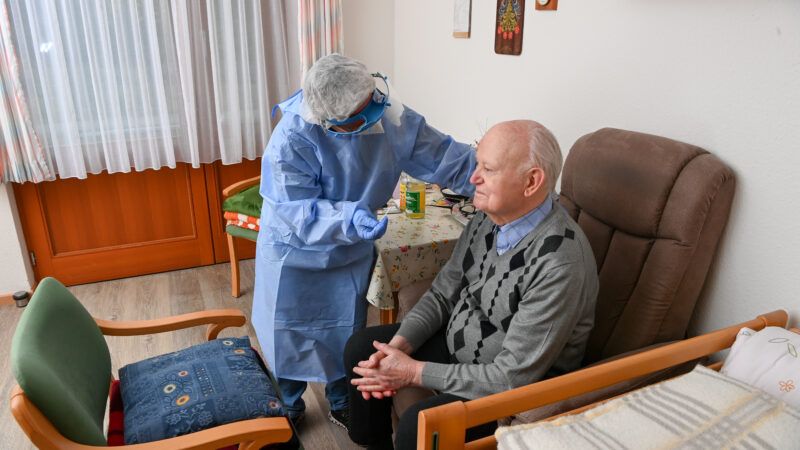For-Profit Nursing Homes Had Less Severe Lockdowns, Lower Fatality Rates During Pandemic
A new paper from Mercatus shows how profit motive helped some nursing homes navigate COVID-19 better than others.

Nursing homes operating as for-profit enterprises generally implemented less severe lockdowns during the COVID-19 pandemic than their nonprofit and government-run counterparts.
Doing so may have saved lives.
A working paper published Wednesday by the Mercatus Center at George Mason University finds that the number of visits to for-profit nursing homes declined less dramatically and rebounded more quickly than at other facilities with different management structures. Vitor Melo, the paper's author, argues that profit motive likely nudged managers at for-profit nursing homes to make decisions that better balanced the needs of staff and residents.
"Restrictive isolation measures present a trade-off for residents," writes Melo. "These measures benefit residents by decreasing their chances of getting and dying from COVID-19. But they impose high costs on residents by preventing them from being with their families and friends, which negatively affects their mental health and can potentially expedite death from other causes."
By comparison, he writes, nonprofit and government-run facilities may have been more likely to prioritize the interests of staff, for whom intensive lockdowns carried less of a cost since they could leave at the end of their shifts, go home, and see loved ones.
Nursing homes were in many ways ground zero of the COVID-19 pandemic, due to the vulnerability of residents and the degree of control that could be exercised by staff and management. Many of the worst outbreaks during the early stages of the pandemic were in nursing homes, and more than one-third of all COVID-related deaths in the United States during the first year of the pandemic occurred in nursing homes and other long-term care facilities.
Protecting residents from COVID was therefore an important objective for nursing home managers, but Melo's paper makes the case that extended periods of isolation came with other potentially deadlier tradeoffs. Melo's statistical model shows that between June 2020 and March 2022, not-for-profit nursing homes had fewer COVID deaths but an overall higher fatality rate than for-profit nursing homes during the same period.
"If not-for-profit nursing homes implemented more restrictive isolation measures, these policies are likely to increase rates of depression and mental illnesses, as well as the rate of health deterioration of residents with brain-related diseases such as dementia," he writes. "Thus, nursing homes with more restrictive isolation measures are expected to have more non-COVID deaths even after these measures end."
"The increase in non-COVID deaths caused by more restrictive isolation measures," Melo concludes, "outweighed the decrease in COVID-19 deaths associated with those measures."
Because their residents were, in effect, paying customers, for-profit nursing homes had to take into account how their policies would deter or attract future customers. Nonprofits and government-run facilities could discount those concerns more easily, which took the financial sting out of extended lockdowns but may have led to worse outcomes for their residents in the long run.
Melo's paper suggests that patients in general might be better served if there's a larger profit motive to guide health care providers' decision making—even when there isn't a pandemic happening.


Show Comments (17)